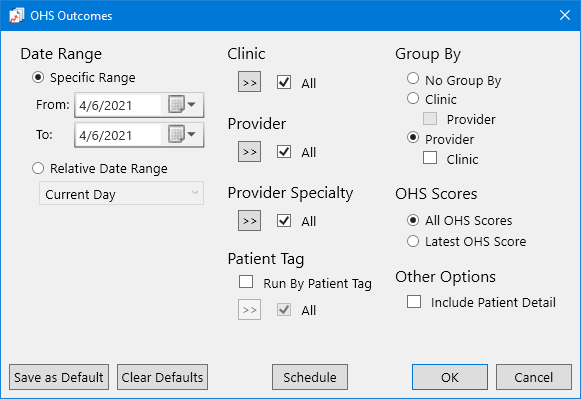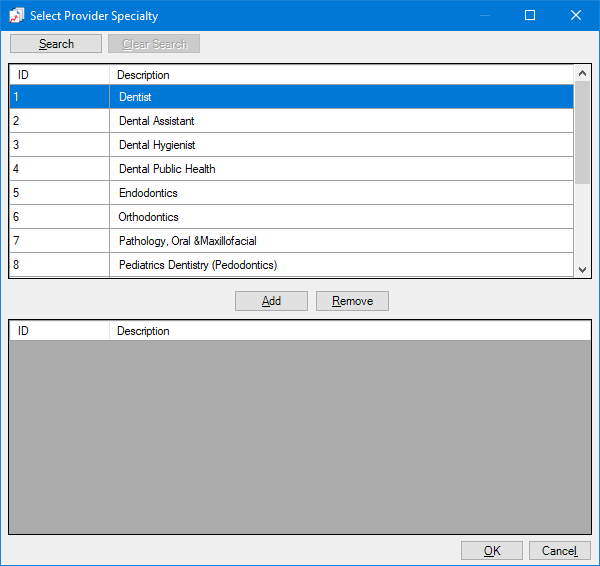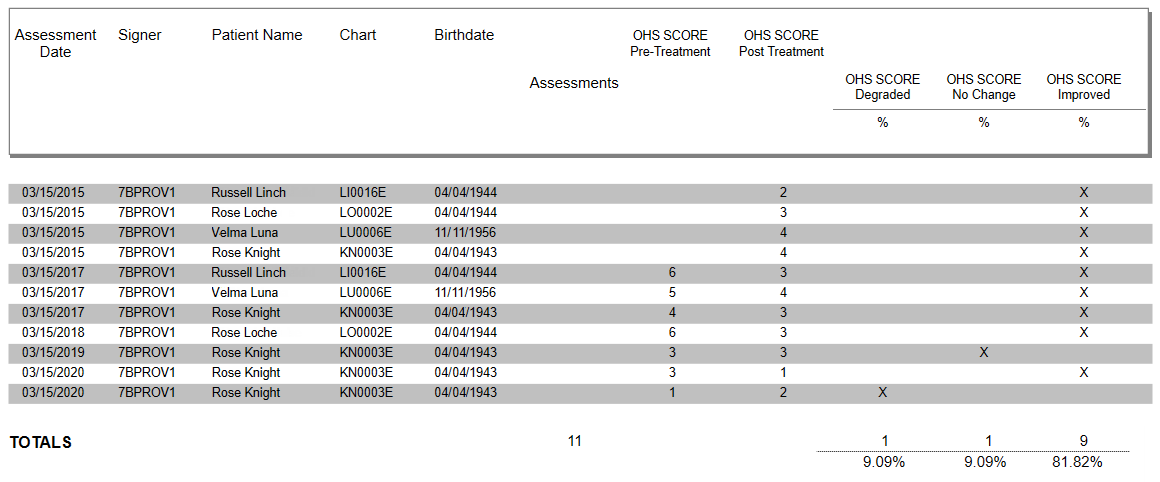The OHS Outcome after Appointment Report measures changes in oral health after appointments, which may indicate the benefit or effectiveness of treatment performed. This report should be used at the Service Unit level only.
Note: This report is available only if the global setting for the Oral Health Status features is enabled.
To run the report
In DXOne Reporting, select Custom, and then double-click OHS Outcome after Appointment Report.
The OHS Outcomes dialog box appears.

Set up the following options:
Date Range - To filter the report by date, do one of the following:
To include patients with assessments that have dates within a range that you specify, select the Specific Range option. With this option selected, do one of the following:
Enter a date range (in a m/d/yyyy format) in the From and To boxes.
To select a date, do the following for From and To:
Click the corresponding calendar icon to view a month calendar.

Navigate to the correct month, using the left and right arrows.
Note: To quickly change the year and month, click the month-year at the top of the calendar, navigate to the correct year, using the left and right arrows, and then click the correct month.
Click the correct day.
To include patients with assessments that have dates within a range that is relative to the report date, select the Relative Date Range option. With this option selected, select one of the following relative date ranges from the list:
Current Day Current MTD Current Fiscal YTD Current Calendar YTD |
Previous Day Previous Week Previous Month Previous 3 Months Previous 6 Months Previous Fiscal Year Previous Calendar Year |
Note: There are no future date ranges because they are not relevant for this report.
Clinic - To filter the report by the clinics that users were logged in to when assessments were done, do one of the following:
To include all clinics that you are allowed to generate the report for, select the All checkbox.
To include specific clinics, do the following:
Click the search button  .
.
The Select Clinics dialog box appears.

Note: Only the clinics that you are allowed to generate the report for are available.
If the list is long, to search for a clinic by ID and/or title, do the following:
Click Search.
The options for searching appear in the upper list.

Enter the first character or more of a clinic's ID and/or title in the ID and Practice Title boxes, respectively.
Click Show Results to view a list of matching clinics.
Note: To return to viewing the list of all the clinics, click Search, click Clear Search to clear the search criteria that you entered, and then click Show Results.
In the upper list, select one or more clinics.
Note: To select multiple clinics, click a clinic, and then, while pressing the Ctrl key, click the other desired clinics. To select a range of adjacent clinics, click the first clinic of the desired range of clinics, and then, while pressing the Shift key, click the last clinic of the desired range of clinics.
Click Add.
Repeat steps b-d as needed to add other clinics.
Note: To not include a clinic that you added, select that clinic in the lower list, and then click Remove.
Click OK.
Provider - To filter the report by the providers who signed the associated clinical notes that are associated with assessments, which may differ from the logged-in users who entered assessments, do one of the following:
To include all providers that you are allowed to generate the report for, select the All checkbox.
To include specific providers, do the following:
Click the search button  .
.
The Select Providers/Staff dialog box appears.

Note: Only the providers and staff that you are allowed to generate the report for are available.
If the list is long, to search for a provider by ID, first name, last name, and/or title, do the following:
Click Search.
The options for searching appear in the upper list.

Enter the first character or more of a provider's ID, first name, last name, and/or title in the ID, First Name, Last Name, and Title boxes, respectively.
Click Show Results to view a list of matching providers and staff members.
Note: To return to viewing the list of all the providers and staff members, click Search, click Clear Search to clear the search criteria that you entered, and then click Show Results.
In the upper list, select one or more providers.
Note: To select multiple providers, click a provider, and then, while pressing the Ctrl key, click the other desired providers. To select a range of adjacent providers, click the first provider of the desired range of providers, and then, while pressing the Shift key, click the last provider of the desired range of providers.
Click Add.
Repeat steps b-d as needed to add other providers.
Note: To not include a provider that you added, select that provider in the lower list, and then click Remove.
Click OK.
Provider Specialty - To filter the report by the specialties that are assigned to providers who signed the clinical notes that are associated with assessments, do one of the following:
To include all provider specialties, select the All checkbox.
To include specific provider specialties, do the following:
Click the search button  .
.
The Select Provider Specialty dialog box appears.

If the list is long, to search for a provider specialty by ID and/or description, do the following:
Click Search.
The options for searching appear in the upper list.

Enter the first character or more of a provider specialty's ID and/or description in the ID and Description boxes, respectively.
Click Show Results to view a list of matching provider specialties.
Note: To return to viewing the list of all the provider specialties, click Search, click Clear Search to clear the search criteria that you entered, and then click Show Results.
In the upper list, select one or more provider specialties.
Note: To select multiple provider specialties, click a provider specialty, and then, while pressing the Ctrl key, click the other desired provider specialties. To select a range of adjacent provider specialties, click the first provider specialty of the desired range of provider specialties, and then, while pressing the Shift key, click the last provider specialty of the desired range of provider specialties.
Click Add.
Repeat steps b-d as needed to add other provider specialties.
Note: To not include a provider specialty that you added, select that provider specialty in the lower list, and then click Remove.
Click OK.
Patient Tag - Do one of the following:
To not filter the report by a patient tag, clear the Run By Patient Tag checkbox.
To filter the report by the tags that are assigned to patients who have assessments entered in their records, select the Run By Patient Tag checkbox. With this checkbox selected, the options to filter the report by tag are available. Do one of the following:
To include patients with any patient tag, select the All checkbox.
To include patients with specific tags, do the following:
Click the search button ![]() .
.
The Patient Tag Selection dialog box appears.

If the list is long, to search for a patient tag, do the following:
Click Search.
The options for searching appear in the upper list.

Enter the first character or more of a patient tag name in the Tag Name box.
Click Show Results to view a list of matching patient tags.
Note: To return to viewing the list of all the patient tags, click Search, click Clear Search to clear the search criteria that you entered, and then click Show Results.
In the upper list, select one or more patient tags.
Note: To select multiple patient tags, click a patient tag, and then, while pressing the Ctrl key, click the other desired patient tags. To select a range of adjacent patient tags, click the first patient tag of the desired range of patient tags, and then, while pressing the Shift key, click the last patient tag of the desired range of patient tags.
Click Add.
Repeat steps b-d as needed to add other patient tags.
Note: To not include a patient tag that you added, select that patient tag in the lower list, and then click Remove.
Click OK.
Group By - Select one of the following options:
No Group By - For no grouping. The summary report will be generated. The overall total number of patients appear on the report.
Clinic - To group the report by clinic.
Do one of the following:
To not group the report by provider within each clinic grouping, clear the Provider checkbox. The report displays totals for each clinic.
To group the report by provider within each clinic grouping, select the Provider checkbox. For each provider, the report displays totals that are related to the outer clinic grouping. The report displays totals for each clinic.
Provider - To group the report by provider.
Do one of the following:
To not group the report by clinic within each provider grouping, clear the Clinic checkbox. The report displays totals for each provider.
To group the report by clinic within each provider grouping, select the Clinic checkbox. For each clinic, the report displays totals that are related to the outer provider grouping. The report displays totals for each provider.
Other Scores - Select one of the following options to specify the amount of OHS scores that will be displayed from the amount available during the specified time frame:
All OHS Scores - The report displays all the OHS score changes that occurred during the selected time frame for the patients that had OHS score changes.
Latest OHS Score - The report displays only the most recent OHS score changes that occurred within the time frame for the patients that had OHS score changes.
Other Options - Select or clear the following checkbox:
Include Patient Detail - With this checkbox selected, the report includes details regarding the assessments that were completed for patients. With this checkbox clear, the report does not include details regarding assessments.
Click Save as Default to save the current settings for the next time you run the report.
Click Clear Defaults to revert the dialog box options to the original defaults.
Click Schedule to schedule a report job.
Click OK to preview the report.
Report examples
No grouping, without patient detail:

No grouping, with patient detail:

The report displays the following information:
Patient Details - If the report includes patient details, the post-treatment assessments are sorted first by date (in chronological order) and then by patient name (in alphabetical order, by first name and then last name). A post-treatment assessment is included on the report if the assessment was completed within the date range for the report, the assessment is linked to a clinical note, and the other report criteria are met.
Note: There may be multiple post-treatment assessments for a patient on the same day or across multiple days. Each is listed separately.
For each post-treatment assessment, the following details appear:
OHS Score Pre-Treatment - If a pre-treatment assessment was completed prior to the post-treatment assessment, the pre-treatment assessment is linked to a clinical note, and the other report criteria are met (except for the date range), the pre-treatment assessment's score appears. The OHS Score Pre-Treatment is different from the pre-treatment assessment's recorded score if one of the following conditions is met:
If the score for the pre-treatment assessment was a 1, 2, or 3, and more than 2 years passed until the post-treatment assessment was done, the OHS Score Pre-Treatment changes to 6.
If the score for the pre-treatment assessment was a 4, and more than 2 years but not more than 3 years passed until the post-treatment assessment was done, the OHS Score Pre-Treatment changes to 5.
If the score for the pre-treatment assessment was a 4, and more than 3 years passed until the post-treatment assessment was done, the OHS Score Pre-Treatment changes to 6.
Notes:
If a pre-treatment assessment does not exist, the OHS Score Pre-Treatment is blank, and the assessment is included in the OHS Score Improved.
The date when a pre-treatment assessment was completed can fall outside of the date range for the report.
OHS Score Post Treatment - The post-treatment assessment's score.
Assessment Date - The date when the post-treatment assessment was completed.
Signer - The user ID of the provider who signed the associated clinical note.
Patient Name - The patient's name.
Chart - The patient's chart number.
Birthdate - The patient's birth date (if entered in Family File record).
Score change - An "X" appears in one of the following columns to indicate how the patient's OHS score has changed:
OHS Score Degraded - If the OHS Score Post Treatment is higher than the OHS Score Pre-Treatment.
OHS Score No Change - If the OHS Score Post Treatment is the same as the OHS Score Pre-Treatment.
OHS Score Improved - If the OHS Score Post Treatment is lower than the OHS Score Pre-Treatment, or if the OHS Score Pre-Treatment is blank.
Totals - The following subtotals (for each grouping), if applicable, and totals (for the entire report) appear:
Assessments - The number of post-treatment assessments.
OHS Score Degraded - The number of post-treatment assessments that have an OHS Score Degraded.
% OHS Score Degraded - The OHS Score Degraded divided by the Assessments.
OHS Score No Change - The number of post-treatment assessments that have an OHS Score No Change.
% OHS Score No Change - The OHS Score No Change divided by the Assessments.
OHS Score Improved - The number of post-treatment assessments that have an OHS Score Improved.
% OHS Score Improved - The OHS Score Improved divided by the Assessments.
Note: There may be multiple post-treatment assessments for a patient on the same day or across multiple days. Each is counted separately toward the applicable totals.